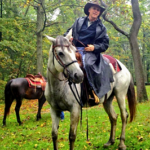
August 15, 2008
In a disturbing snapshot taken immediately after last spring’s Kentucky Derby, Eight Belles, the second-place filly, struggles to her feet while the men around her desperately try to push her back to the ground. One of her two fractured front legs is traumatically crooked. In the background are dozens of spectators, heads turned from the proud victory horse to the collapsing runner-up, who had stood on her four powerful legs for the last time.
In a society fascinated by the extraordinary athleticism of horses, how have we allowed the sport of horse racing to stray so far from the celebration of horses’ natural capabilities?
An Associated Press study in June 2008 revealed that 5,000 horse deaths have occurred on racetracks in the United States in the past five years. This discovery reminds us that it’s not just the notable fatalities like Barbaro (Preakness Stakes 2006), George Washington (2007 Breeder’s Cup), and Eight Belles that define racing’s brutal reputation.
Due in part to the sequence of horse fatalities, this summer marks a critical time in horse racing. Changes in industry and government standards concerning horse safety will have a major effect on the sport’s future.
As a horse owner, you’re likely compassionate about the treatment of all horses. Read on for our special report on the state of horse racing today, and decide for yourself where the welfare of racehorses fits into the sport’s priorities.
Congress Steps In
After the Kentucky Derby’s tragic finish, the U.S. House of Representatives stepped in to voice concern regarding the racing industry. The Committee on Energy and Commerce, which oversees interstate sports-related matters, sent letters to key players in the horse industry. These players included The Jockey Club (the registry of U.S. Thoroughbreds), owners of major racetracks, and Racing Commissioners International.
We’ve all heard the hype surrounding problems with racing, but the committee’s letters pinpointed the pressing issue at hand. “The thoroughbred breed has become increasingly fragile and incapable of withstanding previously acceptable rigors of dirt racing on the track.”
The letters went on to say that two problems were at hand:
1. Breeders may be at fault for opting to produce horses that run fast at a young age but are less durable as they get older.
2. The use of performance-enhancing drugs is “warping the breed,” because horses normally considered unsound are able to compete successfully on steroids. As a result, they’re seen as desirable candidates for breeding, but their genetic weaknesses are overlooked.
On June 19, 2008, the committee held a hearing with letter recipients, as well as prominent racehorse owners. Both issues were discussed, as well as another important question: Does the horse racing industry need a central governing body?
The Doping Factor
You might assume that horse racing, like other national sports, is organized by a national league or association. But this isn’t the case. Instead, each state is authorized to decide on important issues, such as whether or not certain steroids can be used during races.
Of the 38 states where racing is legal, 28 allow the use of steroids. This number includes the states where the Triple Crown races are held: Kentucky, Maryland, and New York.
In 2008, Big Brown captured the Kentucky Derby, beating second-place finisher Eight Belles by five lengths. Big Brown raced while on a steroid called Stanozolol (brand-name Winstrol). His trainer, Rick Dutrow, claimed that he used Winstrol on all his horses. The horse’s veterinarian explained in an interview for the New York Times that the idea behind injecting race horses consistently is to enhance their appetite and keep them in top shape for competing every three to four weeks. Meanwhile, Eight Belles ran the Derby clean.

When the Belmont Stakes rolled around several weeks later, Big Brown came in last place. Dutrow had announced that the horse wouldn’t be injected, because he didn’t want to push him too hard due to so many races in a short period of time. But the drastic difference in the colt’s performance brought extra attention to the questions surrounding the capabilities of doped horses.
Was doping the only factor in the Derby win? Further research showed that Eight Belles’ inbred pedigree might’ve been to blame, as well. Native Dancer, a record-breaking racehorse in the 1950s, was in the filly’s pedigree. And Native Dancer’s career came to an early end due to the chronic ankle inflammation that rendered him unsound.
Every one of the horses that raced at the 2008 Derby carried Native Dancer’s blood, but Eight Belles’ family tree traced back to the unsound stallion four times. The impact of Eight Belles’ breeding on her bones is speculative; for one report, by ESPN, see the live-link box.
Industry Response
Government scrutiny and media heat have triggered serious responses within the horseracing industry. Several days after the 2008 Kentucky Derby, The Jockey Club created the Thoroughbred Safety Commission, which has proposed serious racing-safety reforms.
In early July, Kentucky’s governor replaced the Kentucky Horse Racing Authority with the Kentucky Horse Racing Commission to give the issue of steroid use priority. On July 14, the KHRC voted to limit toe grabs, a type of stud on the front horseshoes that provides more traction.
Both the TSC and the KHRC plan to vote on steroids’ legality by the end of the summer, which will be significant and influential steps in the industry. The KHRC’s decision will determine whether steroids will be used on Kentucky racetracks going forward.
Outlaw or Reform?
Controversies in the horseracing industry aren’t new. Some equine enthusiasts we talked to say that everything about racing is downright cruel, and it would be a good thing to just ban it all together. No more racehorses sent to slaughter. No more questions about steroids or how hard a horse can be whipped or what sorts of horseshoe studs should be allowed.
But it’s not that easy. For one, erasing the sport would have a sizeable impact on our country’s economy. According to a 2005 American Horse Council study of the horse industry, racing contributes $26.1 billion to the United States’ Gross Domestic Product annually.
And the sport contributes considerably to many state economies-the KHRC cites it as the state’s No. 1 industry. Therefore, reform, rather than a total ban, might be the logical next step.
Our government and horse racing’s leaders are at a crossroads at which they must evaluate the importance of racehorses’ well-being. As they do, consider voicing your opinion on this issue. For how to do so, see the live-link box.
Lauren Anne Back is the associate editor of The Trail Rider and contributing editor of MyHorse.com.
Live Links
To see the photos from the Kentucky Derby,click here
To read the letters sent out by the Committee on Energy and Commerce,click here
To read ESPN’s report on Eight Belles’ breeding,click here
To read about the Humane Society of the U.S.’s outlook on change in the sport,click here
Voice your opinion by writing to the National Horsemen’s Benevolence & Protective Association, the Committee on Energy and Commerce







